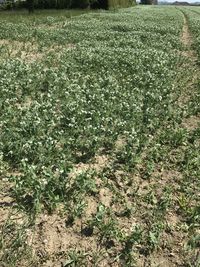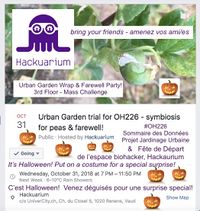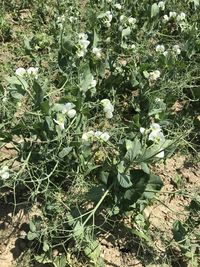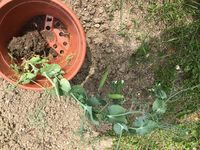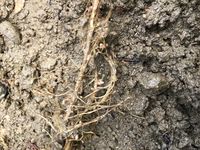Urban gardens with rhizobial bacteria
An initial trial for a project focussed on urban gardens with rhizobial bacteria will test whether specific rhizobial bacteria will improve the growth of peas when used by ordinary people.
To note: such cultures are normally used on the agro-business scale!
Here is some basic info about such symbiosis for nitrogen utilisation by plants.
The rhizobial strain needed for peas, Rhizobium leguminosarum Jordan, was ordered from ATCC and has been grown with a special peat moss media. These are being used for controlled tests on symbiotic effects on pea harvests.
UPDATE: 31.3.19 There are discussions with the Ville de Lausanne and the Ecublens schools about collaborations on this project
- The meeting about the 1st year's data came to the conclusion that it is worth more testing. this is the prezi used for the 31oct summary during the farewell party
old news: 25 October, a summary of the data obtained in this first urban garden trial will be presented for #OH226, the 31st of October
!
This Open Hackuarium will also provide the occasion for a farewell party for Hackuarium, which already moved its lab equipment from the Renens site, and is still looking for its new 'chez nous' to set up with the new cooperative (including Octanis and others)!!
Come join us!
previous news: 20 October, none of the pods on the plants seem to be developing further outdoors. (With temps below 10oC, some days, not very surprising)
old news: 1 October, some pods were harvested, and 15 october even more... Could this urban garden trial be the world record for pea harvests outdoors, in such a season?
old news: 27 Sept: Most participants' pots are not doing so well, but some are still growing, and (surprise!) there have even been flowers and actual pea pods on many plants in people's gardens! Will we have a record late pea harvest (already in Fall!)?? The big wrap event for the project is still planned for 31Oct! (The Salle Gaston Lagaffe on the 3rd floor - ch du Closel 5, 1020 Renens - has been reserved.) Please save the date!
The google drive for the data from participants is organised, so everyone can add info to a spreadsheet (the more numbers the better - one participant is already measuring average heights of the plants in his pots) and post images of their plants. The minimal requirement is one picture per week, and counting all the pea pods, but the more numbers we can get, the better. Everyone also needs to try to make sure the plants from the 2 pots get as close to the same conditions as possible, for light, water etc. but can keep them in the pots or put them in the garden, as they like. Hoping for a good harvest!
Watch this space!
More will come soon, and new pages... TRANSLATORS REQUESTED! ( all the below is being left for historical purposes)
Two germination trays and a new set of pea seeds (for late season planting!) are ready.
Half of the seeds will be sprouted in the tray with no inoculum, and half in a tray also containing the special bacteria.
(conc to be decided still)
We are still following these recommendations but will not simply soak the peas overnight, but rather put them on paper towels for the initial germination before inoculation. Half of these seeds will be inoculated with the symbiotic bacterial strain before putting them into the soil in germination trays.
The other half will be 'mock inoculated' with a bit of the culture media. The soil for sprouting in the trays will be autoclaved again (and is 'bio'), for the germination, but participants decide and document what they do with the baby plants subsequently...
Of course, watering and pictures are highly recommended!
First, percentage of germination for both trays will be quantitated (hoping there is no special effect of the inoculum!).
Then, we will pass on plants to our recruits (trial participants) that have home gardens (potager) or even just balcony space, potentially, and are willing to document the growth of their seedlings.
Ideally, the participants will take about a dozen of each sprout (inoculated and control, coded, however, so they don't know which group is which), and after a few weeks of growth we will have them look closely at roots for maybe 2 plants of each batch, trying to quant number of nodules per cm of root... (for example)
Care will need to be taken in this process, so hopefully there won't be damage to the plants, but as long as more than 5 remain undisturbed and grow until harvest, we should be in ok shape...
Additionally, the number of plants to adulthood (making flowers, making a pea crop) will be scored, then finally number of pods and number of peas will be also obtained.
From 10 plants (or 12 in cases where the nodule counts don't ruin everything - if care taken, reportedly possible) we could get a good idea about how effective the treatment was from these numbers.
How many seeds in packet? about 100 - did two packages
How many people are interested?
Several signed on at the #OH200, 2May.
What do they take them home in? in pots...
to keep identities 'blind' decided to just label the two groups A or B, and the secret code (for inoculated or mock-inoculated) won't be revealed until the very end of the expt (grand recap planned for 31oct18)!
---
If possible, soils might be saved and used for 2nd test (?? just from resid plants in initial tray tests) for long term fertility for a second crop (non-legumous, tomatoes?).
---
There is some good background information here about how important the correct rhizobial bacteria in nodules are for nitrogen fixing... (in the context of peanuts, however, which symbiose with a different bacterial species)
Here is some more insiprational citizen science - a monoculture vs polyculture experiment.
